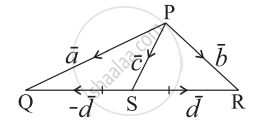Advertisements
Advertisements
Question
State whether the expression is meaningful. If not, explain why? If so, state whether it is a vector or a scalar:
`|bar"a"|(bar"b".bar"c")`
Solution
This is the product of two scalars. Therefore, this expression is meaningful and it is a scalar.
APPEARS IN
RELATED QUESTIONS
If \[\vec{a}\] and \[\vec{b}\] are two non-collinear vectors such that \[x \vec{a} + y \vec{b} = \vec{0} ,\] then write the values of x and y.
If G denotes the centroid of ∆ABC, then write the value of \[\overrightarrow{GA} + \overrightarrow{GB} + \overrightarrow{GC} .\]
If \[\overrightarrow{a} = \hat{i} + \hat{j} , \vec{b} = \hat{j} + \hat{k} \text{ and }\vec{c} = \hat{k} + \hat{i} ,\] write unit vectors parallel to \[\overrightarrow{a} + \overrightarrow{b} - 2 \overrightarrow{c} .\]
If \[\overrightarrow{a} = \hat{i} + 2 \hat{j} , \vec{b} = \hat{j} + 2 \hat{k} ,\] write a unit vector along the vector \[3 \overrightarrow{a} - 2 \overrightarrow{b} .\]
If \[\overrightarrow{a} = \hat{i} + \hat{j} , \overrightarrow{b} = \hat{j} + \hat{k} , \overrightarrow{c} = \hat{k} + \hat{i}\], find the unit vector in the direction of \[\overrightarrow{a} + \overrightarrow{b} + \overrightarrow{c}\].
Write a unit vector in the direction of the sum of the vectors \[\overrightarrow{a} = 2 \hat{i} + 2 \hat{j} - 5 \hat{k}\] and \[\overrightarrow{b} = 2 \hat{i} + \hat{j} - 7 \hat{k}\].
Find the value of 'p' for which the vectors \[3 \hat{i} + 2 \hat{j} + 9 \hat{k}\] and \[\hat{i} - 2p \hat{j} + 3 \hat{k}\] are parallel.
If O and O' are circumcentre and orthocentre of ∆ ABC, then \[\overrightarrow{OA} + \overrightarrow{OB} + \overrightarrow{OC}\] equals
If ABCDEF is a regular hexagon, then \[\overrightarrow{AD} + \overrightarrow{EB} + \overrightarrow{FC}\] equals
ABCD is a parallelogram with AC and BD as diagonals.
Then, \[\overrightarrow{AC} - \overrightarrow{BD} =\]
If OACB is a parallelogram with \[\overrightarrow{OC} = \vec{a}\text{ and }\overrightarrow{AB} = \vec{b} ,\] then \[\overrightarrow{OA} =\]
In the given figure express `bar"c"` and `bar"d"` in terms of `bar"a"` and `bar"b"`.

Select the correct option from the given alternatives:
Let α, β, γ be distinct real numbers. The points with position vectors `alphahat"i" + betahat"j" + gammahat"k", betahat"i" + gammahat"j" + alphahat"k", gammahat"i" + alphahat"j" + betahat"k"`
Let `bara = hati - hatj, barb = hatj - hatk, barc = hatk - hati.` If `bard` is a unit vector such that `bara * bard = 0 = [(barb, barc, bard)]`, then `bard` equals ______.
Find the lengths of the sides of the triangle and also determine the type of a triangle:
A(2, -1, 0), B(4, 1, 1), C(4, -5, 4)
Find the acute angle between the curves at their points of intersection, y = x2, y = x3.
Find the angle between the lines whose direction cosines are given by the equations 6mn - 2nl + 5lm = 0, 3l + m + 5n = 0.
Find a unit vector perpendicular to the plane containing the point (a, 0, 0), (0, b, 0) and (0, 0, c). What is the area of the triangle with these vertices?
State whether the expression is meaningful. If not, explain why? If so, state whether it is a vector or a scalar:
`(bar"a".bar"b").bar"c"`
State whether the expression is meaningful. If not, explain why? If so, state whether it is a vector or a scalar:
`(bar"a".bar"b")bar"c"`
State whether the expression is meaningful. If not, explain why? If so, state whether it is a vector or a scalar:
`|bar"a"|. (bar"b" + bar"c")`
For any non-zero vectors a and b, [b a × b a] = ?
If the vectors `overlinea = 2hati - qhatj + 3hatk` and `overlineb = 4hati - 5hatj + 6hatk` are collinear, then the value of q is ______
Find a vector of magnitude 11 in the direction opposite to that of `vec"PQ"` where P and Q are the points (1, 3, 2) and (–1, 0, 8), respectively.
The angle between the vectors `hat"i" - hat"j"` and `hat"j" - hat"k"` is ______.
If `|vec"a"|` = 3 and –1 ≤ k ≤ 2, then `|"k"vec"a"|` lies in the interval ______.
Using vectors, find the value of k such that the points (k, – 10, 3), (1, –1, 3) and (3, 5, 3) are collinear.
If `vec"a"` is any non-zero vector, then `(vec"a" .hat"i")hat"i" + (vec"a".hat"j")hat"j" + (vec"a".hat"k")hat"k"` equals ______.
Classify the following measures as scalar and vector.
2 meters north-west
Classify the following measures as scalar and vector.
40 watt
If `veca ≠ vec(0), veca.vecb = veca.vecc, veca xx vecb = veca xx vecc`, then show that `vecb = vecc`.
If two or more vectors are parallel to the same line, such vectors are known as:
If `veca = hati - hatj + 7hatk` and `vecb = 5hati - hatj + λhatk`, then find the value of λ so that the vectors `veca + vecb` and `veca - vecb` are orthogonal.
Check whether the vectors `2 hati + 2 hatj + 3 hatk, -3 hati + 3 hatj + 2 hatk "and" 3 hati + 4 hatk` from a triangle or not.
Check whether the vectors `2hati + 2hatj + 3hat k, -3hati + 3hatj + 2hat k` and `3hati + 4hatk` form a triangle or not.
lf ΔABC is an equilateral triangle and length of each side is “a” units, then the value of `bar(AB)*bar(BC) + bar(BC)*bar(CA) + bar(CA)*bar(AB)` is ______.
Check whether the vectors `2hati + 2hatj + 3hatk, -3hati + 3hatj + 2hatk and 3hati + 4hatk` form a triangle or not.
Consider the following statements and choose the correct option:
Statement 1: If `veca` and `vecb` represents two adjacent sides of a parallelogram then the diagonals are represented by `veca + vecb` and `veca - vecb`.
Statement 2: If `veca` and `vecb` represents two diagonals of a parallelogram then the adjacent sides are represented by `2(veca + vecb)` and `2(veca - vecb)`.
Which of the following is correct?
